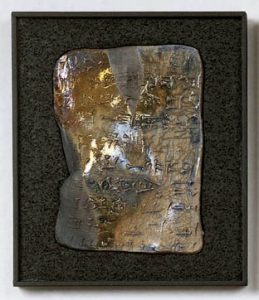 Da molti anni il mio lavoro orbita intorno alla scrittura, al mio desiderio di renderle omaggio. La scrittura, o meglio, i segni che la compongono, sono la materia della cultura ed iniziano con la storia stessa.
Da molti anni il mio lavoro orbita intorno alla scrittura, al mio desiderio di renderle omaggio. La scrittura, o meglio, i segni che la compongono, sono la materia della cultura ed iniziano con la storia stessa.
“All’alba della scrittura” è un omaggio all’invenzione che ci ha traghettato dalla preistoria alla storia; in particolare all’invenzione dell’alfabeto che, circa 3600 anni fa, ha prodotto il simbolo per eccellenza, il suono che si fa forma, la forma che disegna il pensiero, il pensiero libero dal suo pensatore.
Le pagine dell’alba della scrittura sono i mattoni con cui ho costruito la mia “Torre di Babele”. Sebbene quest’ultima sia stata progettata prima del’11 settembre, oggi la si può considerare un’allusione a quanto provocato dall’attacco a New York. Anche in “Là dove scorre il pensiero” le iscrizioni arcaiche ritornano a simboleggiare il pensiero umano. Questa volta le pagine rimangono impigliate in una “ragnatela” di cavi metallici che rappresenta una struttura neuronale. La mia passione per il paradosso, per il ribaltamento, per l’elasticità estrema, fa sì che gli elementi che ospitano il pensiero (i neuroni) diventino la tela in cui il pensiero s’impiglia e lascia qualche frammento: alla logica, al metodo e all’intuizione il compito di decifrarli. Il contesto fisico in cui il pensiero viene concepito, ovvero il suo contenitore, diviene a sua volta struttura di sostegno, scheletro, contenuto in un’opera che è un omaggio alla ricerca scientifica.
Se da un lato, nella mia ricerca, la scrittura viene eletta ad icona del linguaggio, dall’altro il significato del testo scritto diviene metafora della cultura che lo ha espresso o del contesto cui si riferisce l’opera stessa. In “Che la memoria di ciò che è stato si fonda con la materia che ospita il nostro pensiero”, opera sulla Shoà che prende a simbolo la fila come allucinante modalità di sterminio e annientamento della natura umana, il testo biblico in ebraico forma la texture delle figure umane, il loro corpo, la loro identità. Le opere più recenti quali “Riflessioni sulla convivenza” o “Nei sistemi complessi la reversibilità è un lusso”, incentrate sulla relazione amorosa, recano impresse sulla loro superficie parole d’amore provenienti dal Cantico dei Cantici o da una poesia di Paul Eluard.
Se nella genesi delle mie opere nasca prima l’idea o l’immagine non è di semplice definizione. Una visione affiora inizialmente alla soglia della mia coscienza, un’immagine generale un po’ confusa. A questa visione attribuisco una prima interpretazione, mettendola in relazione con le emozioni, le idee e le parole che la accompagnano o che da essa sono evocate. Ed è proprio questo lavoro di decifrazione del significato che produce, a cascata, una definizione formale precisa e coerente che porta alla realizzazione dell’opera.
I lavori “Riflessioni sulla convivenza” nascono da un’immagine reticolare avvolgente: la trama dell’edera rappresenta la convivenza. Può essere vista e vissuta come gabbia o come struttura su cui edificare.Gli spazi, elemento prezioso in qualunque relazione, sono altrettanto costitutivi dei pieni e, permettendo la permeabilità dell’insieme, ne autorizzano l’appartenenza al mondo vivente.
Tra le maglie che nel tempo sono andate costruendo un solido telaio, a volte poco elastico e persino soffocante, le “parole” dell’amore devono trovare il modo per affiorare. Ciò che le porta alla luce in un lentissimo percorso, quasi una crescita vegetale, è la cura con cui, durante lo scorrere dei giorni, si sostituiscono quelle ormai consunte con altre appena forgiate, intatte e preziose.
In quale direzione si dipaneranno le prossime visioni? Un’immagine di levità, relativa al fenomeno pensiero affiora dal brodo di coltura della fantasia che ha radici profonde nel mio edificio interiore perché, come scrive la poetessa Anne Michaels:
Noi non discendiamo, ma affioriamo dalle nostre storie.
Aperta come un taglio la memoria somiglierebbe
a una sezione trasversale del cuore della terra,
una tavola del tempo geografico.
Volti premono sulla membrana trasparente
tra conoscenza cosciente e conoscenza genetica.
Da “Lago dei due fiumi”, Quello che la luce insegna, Anne Michaels, Ed. Giunti.
